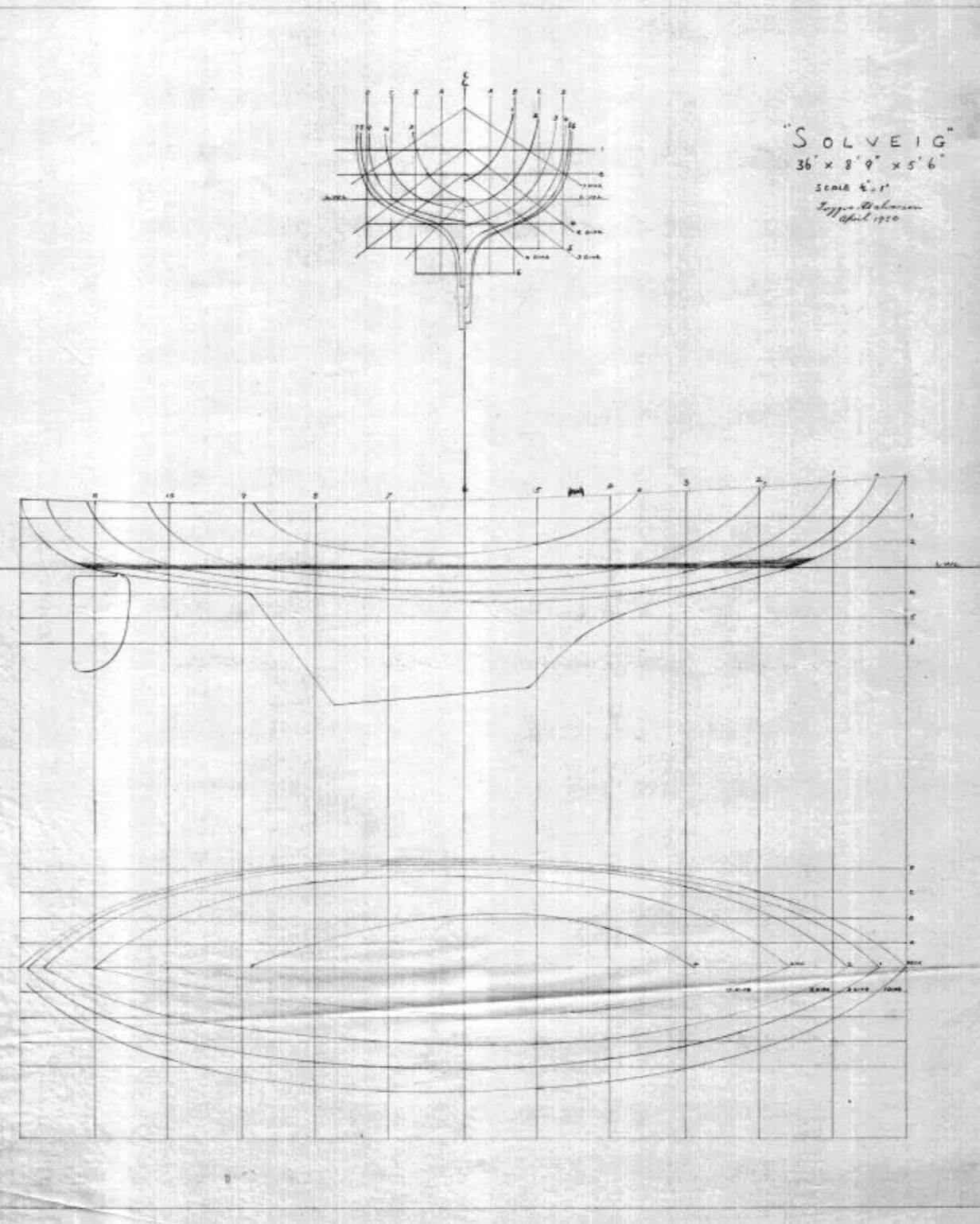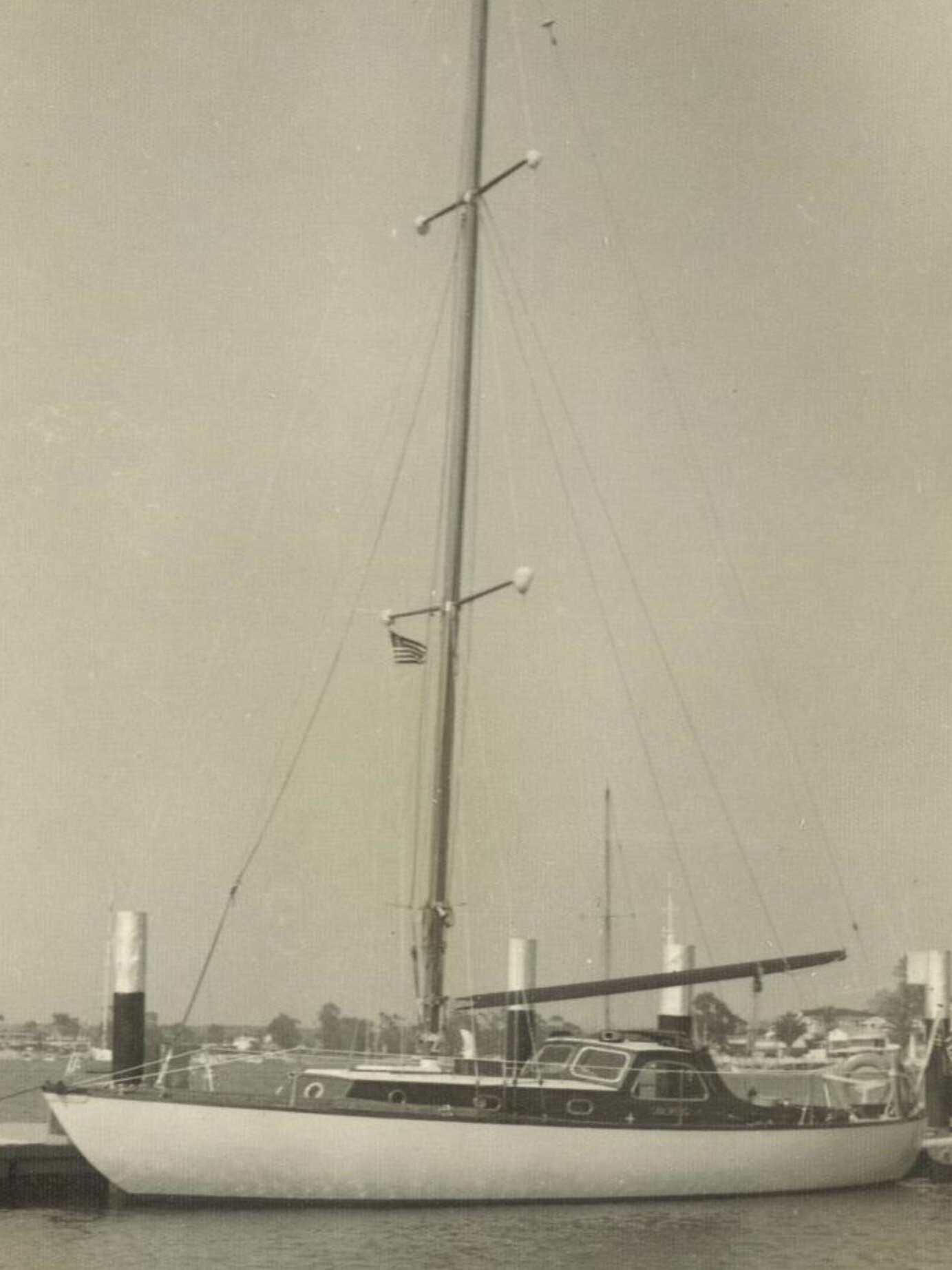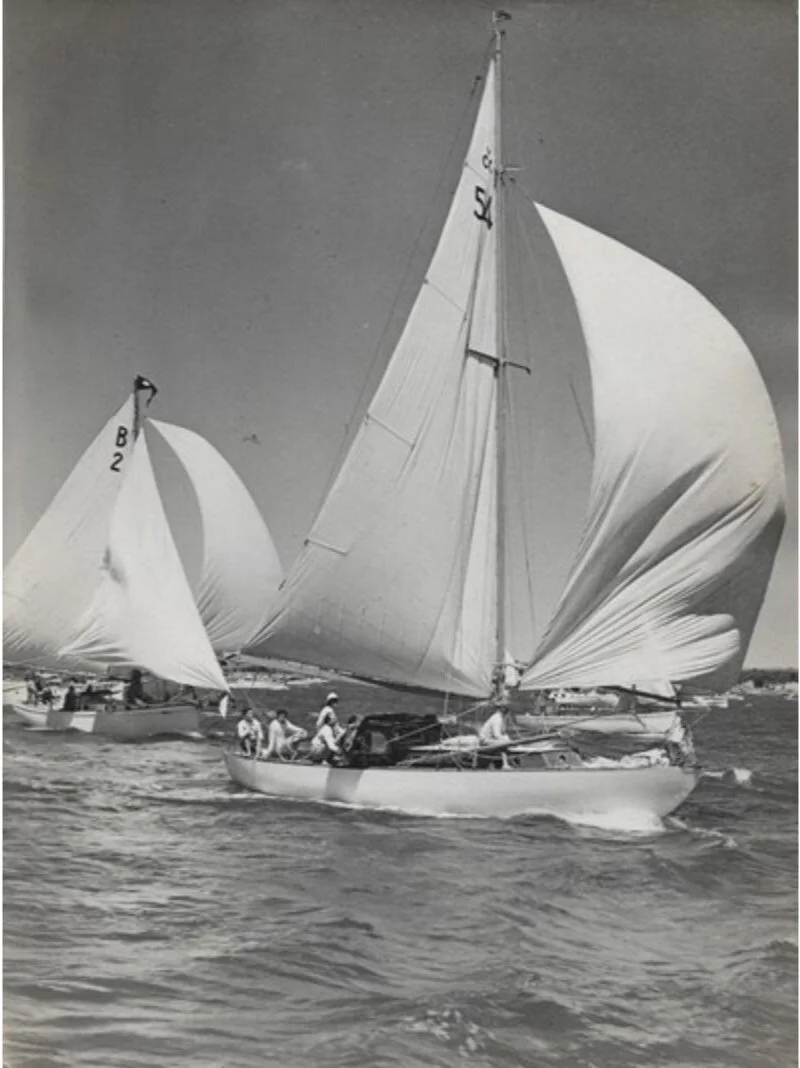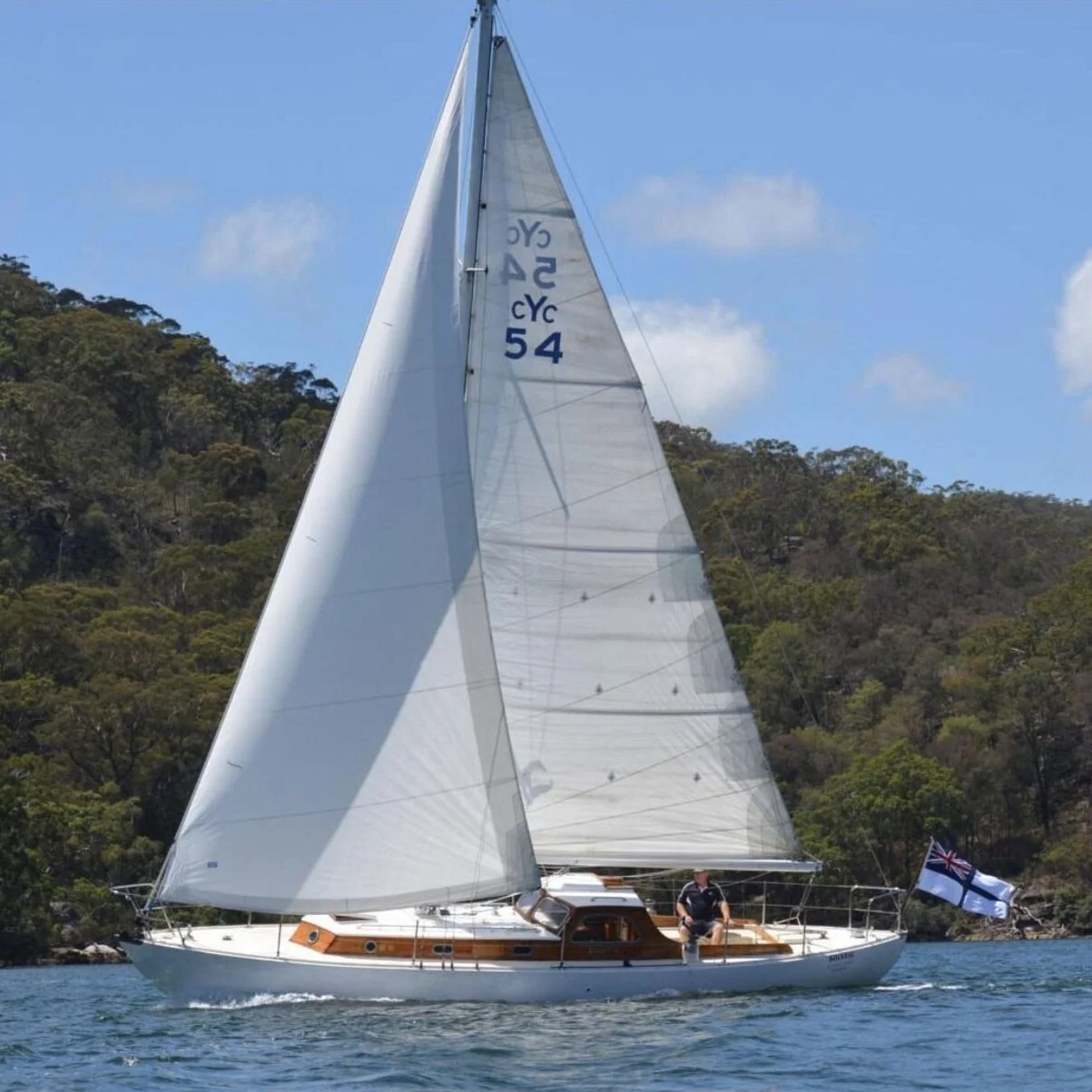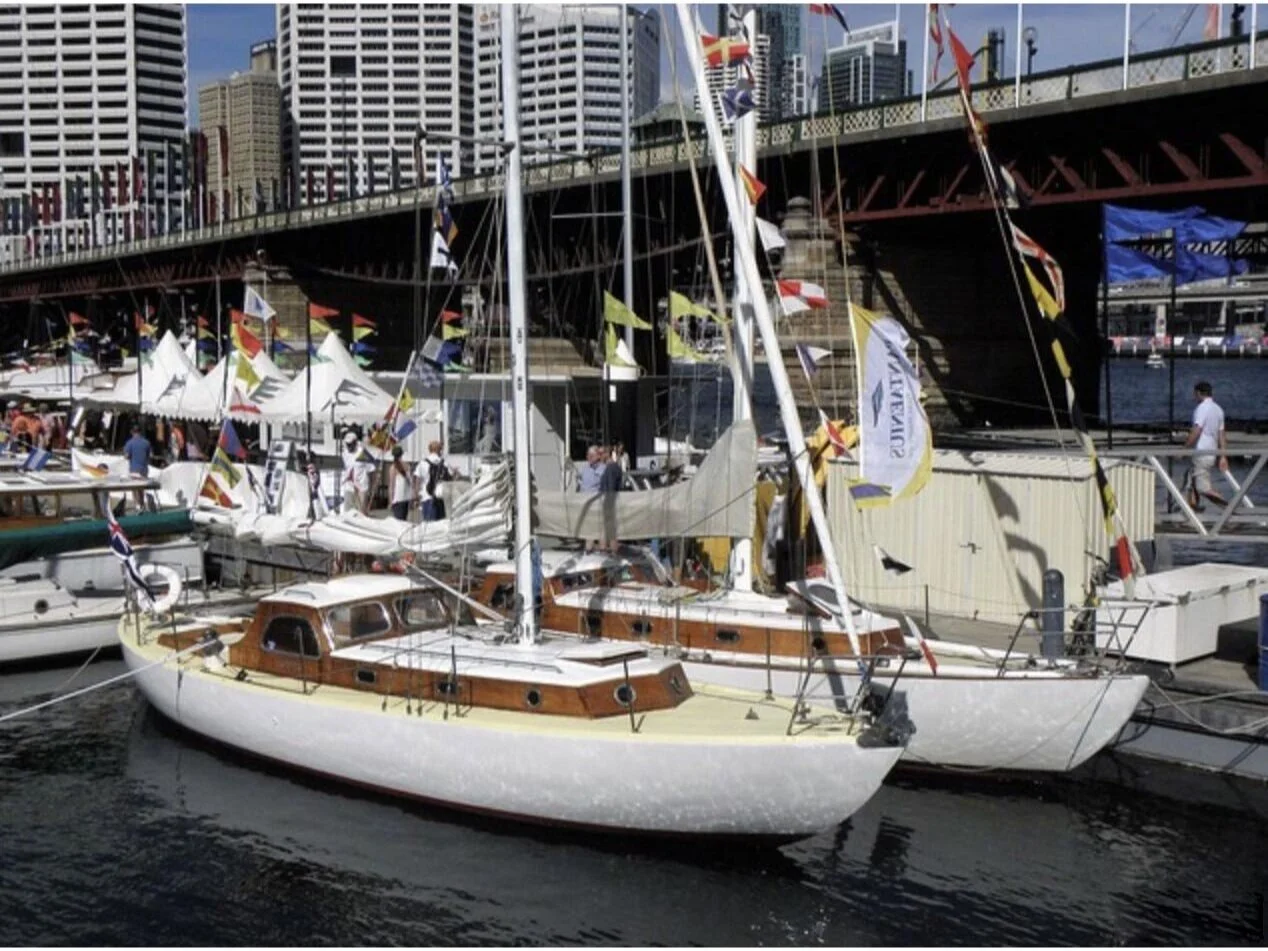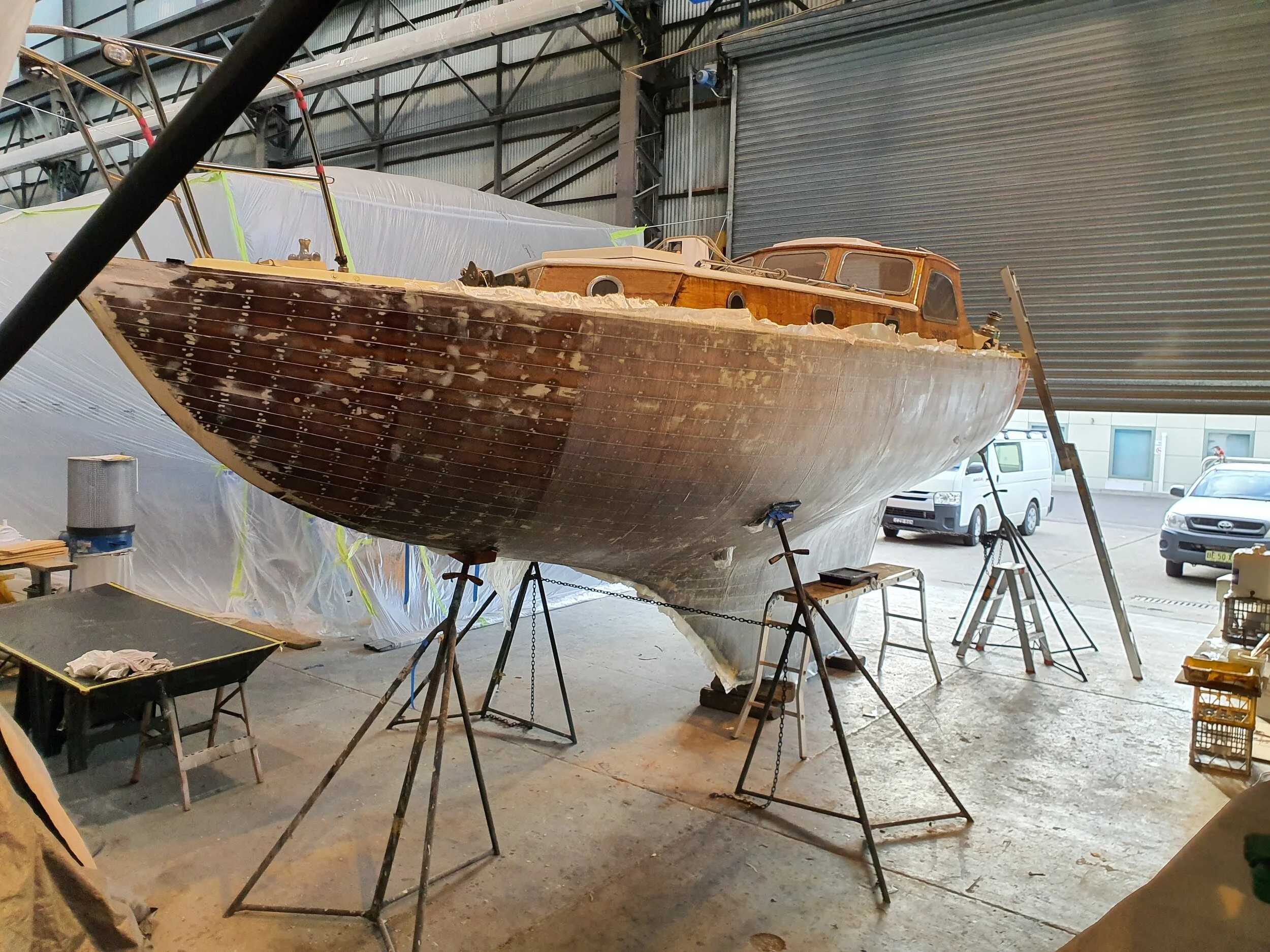SOLVEIG’S SONG: BACK TO HOBART
SOLVEIG finishes the Sydney-Hobart Yacht Race 1950
This Article was posted just before the sudden and understandable cancellation of the 2020 Rolex Sydney Hobart. The copy is therefore out of date, however we have chosen to leave it as published, as it still expresses well, the resolve of the owners and crew. We can only imaging how disappointed they must feel. At this early stage they are determined to be back in 2021!
Earlier this year in a shed at Woolwich Dock, on Sydney harbour, there was a provocative and fascinating reminder of how sailing has changed in the last 70 years.
Two boats were propped on the concrete receiving some tender loving care. Both were past winners of the Sydney to Hobart Yacht Race not only on handicap but also for line honours. One of them is the 100ft maxi WILD OATS XI, a state-of-the-art racer, radically updated almost every year to keep her at the front of the 100ft ocean racing pack, the other was also a radical boat for her time, the 36ft timber sloop SOLVEIG. Only one of them is heading to Hobart this year, and it will be the 70th anniversary of her first trip south.
The early history of this remarkable little boat is well known. SOLVEIG (named after the character in the play ‘Peer Gynt’) was designed and built by members of the famous Halvorsen family in Sydney and represents their first offshore yacht where the design combined speed with safety.
She is carvel planked in Oregon (Douglas fir), which was used in many other parts of the construction including the deck. The varnished cabin sides are teak, as is the trim. SOLVEIG was the first yacht that Trygve designed, his older brother Magnus had designed their previous yachts including PEER GYNT, which Trygve described as an ‘icebreaker’ due to her very heavy construction influenced strongly by the robust, seaworthy designs of the famous Norwegian naval architect Colin Archer.
With SOLVEIG they decided to go for a lighter vessel than PEER GYNT, but retained the seaworthy double ended shape. With a 3/4 fractional sloop rig. Trygve always maintained their philosophy was to design a good fast cruising yacht that could be raced as well, as this would give them a safe and fast yacht that they could still sail hard in rough conditions. SOLVEIG raced in the 1950 Sydney to Hobart race and finished 5th on handicap, an impressive effort considering she had only been in the water for two months.
After this event she crossed the Tasman to Auckland, New Zealand to race in the 1951 Trans-Tasman race and won. The Halvorsens were impressed with her speed downwind so they then took her over to Los Angeles, USA to sail in the 1951 Transpac race to Honolulu, known for consistent downwind sailing. At one point, SOLVEIG was 6th on handicap but did not take a place at the finish, as they experienced two days of unusual, adverse southerly conditions. In July 1951 she was offered for sale in Honolulu, but when no sale eventuated she was delivered back to Sydney by three of the crew.
In 1953 she participated in an ocean race to Noumea, New Caledonia but retired with mast head damage, a rare thing to happen to a Halvorsen yacht. In 1953 she again raced in the Sydney to Hobart, and in a light airs event, won line honours, an unusual result for a small yacht. In 1954 she had her major success winning the Sydney to Hobart race on handicap, and nearly winning line honours again.
After the race SOLVEIG was again an entrant in the Transpac and on arrival in Hawaii was sold to a local, Tom Doyle in 1955. Les Vasconcellos, a diver from the 1950s recalled how he had sailed on SOLVEIG in 1957, when she was moored at the Waikiki Yacht Club. The owner was still Tom Doyle, and while some of the subsequent owners are not recorded, it appears that SOLVEIG remained in the Hawaiian Islands from then onwards. 'Chips' Wheeler took ownership in 2007. He gave her an extensive refit in 2014, reglassing the deck and refastening major fittings, ensuring she was once again ready to cruise offshore.
For a few years Bob Allan in Sydney had been providing Chips with historical information about Solveig and the Halvorsens. In 2016 Chips offered the boat to Bob as he had not found a buyer for a classic in Hawaii. He flew a surveyor out to Honolulu, with the instructions, “I want you to tell me to walk away.” When the surveyor returned, he reported to Bob… “I’ve got some bad news…. she’s in great condition.”
So Bob, with his contacts in the shipping industry including CYCA member Peter Creeden , then head of a shipping line, had her transported back to Sydney where he proceeded to undo all the modifications that had been made over the years, including removing an extra cabin window that wasn’t on the original plans, replacing the standing rigging and getting rid of a 4ft bowsprit that served no function at all apart from increasing her LOA to 40ft, the minimum allowed to be accepted for a berth in the marina in Hawaii!
In April 2019, after ensuring her integrity and survival, Bob was looking to move on and so he put SOLVEIG on the market. His close friends, the experienced offshore sailors Anne Lawrence and John Whitfield came out sailing on the harbour with him. They enjoyed what was then a novel experience of being in a small old wooden boat and over a few months between them all they hatched a plan that was more about custodianship than money. Bob really wanted her to go to somebody who cared…so Anne became the owner.
Anne and John are a husband and wife team who between them have done over 40 Sydney Hobart races.
Anne is an experienced navigator and over the years John has sailed with some of the most successful boats such as the MIDNIGHT RAMBLER dynasty.
Anne talks about how she would often arrive in Hobart after three or four days of intense sailing absolutely exhausted, shower, celebrate and then sleep all night, only to get up in the morning to wander down to the dock to see the small boats come in. If she had been tired, how must these crews feel? So, when she found herself custodian of a famous boat with a famous record in the Bluewater Classic, a spark was lit and the challenge of taking her south again 70 years after her first passage, began to take shape.
However, there was still a considerable amount of work to be done to the boat. In the first few weeks of her life SOLVEIG had a keel hung rudder. The Halvorsens changed this almost immediately to a monel spade rudder separate from the keel. Now Anne and John have replaced it with a slightly bigger version, designed by naval architect Andy Dovel and built by Chris Koreman. But their biggest concern was the integrity of the carvel planked hull. At some stage during her 70 years she had been dynel sheathed and it wasn’t holding up well. The cost of removing this and replacing it appeared to spell the end of any Sydney Hobart plans until help arrived via one of John clients.
Declan Murphy, at the Mortgage Broking firm QuickSelect had been out sailing with Anne and John and while not a passionate sailor he was taken with the history and adventure of what they were trying to achieve. He undertook to support them financially and the work on the hull could begin. So, in February this year we have the amazing sight of the two Sydney Hobart winners, side by side in the Woolwich shed, as SOLVEIG received two brand new layers of fibre glass that will hopefully see her outlive her latest owners! A new set of Dacron sails was ordered from Shane Guanaria at the Doyle loft in Sydney.
Once back in the water, despite all the protocols and holdups caused by Covid-19, a crew of seven was put together. John Whitfeld will be the skipper, Annie is the navigator. Long-time friends on the team Neil Tavener (second in charge) Al Grundy and Andrew Taylor signed up immediately. Mastman Phil Walker had planned to be in Canada for Christmas this year, but now stuck at home due to the pandemic has had his arm twisted into another trip south. Bowman, Tom Dillon is new to the team but has several Hobarts under his belt. Their training focusses more on seamanship than purely going fast. So, reefing, MOB procedures have been an important part of the program.
John says, “she was the TP52 of her day” and in that respect she has no fridge, no stove, no running water and a head open to the cabin. It’s going to be a spartan trip south. They will run watches of three on, three off, with Annie the Navigator floating between the two.
So, what’s the goal of the 620nm trip to Hobart? Anne and John are very clear about this.
“the object of the race for us is to get there…if we get up the Derwent, we’ve won.”
I suppose this leads to the obvious question… why when there is no doubt a multitude of fast, modern boats looking for crew with their experience, why would you commit to the long, slow uncomfortable passage in a 70-year-old wooden lead mine?
There’s the adventure of course, the challenge and reward that comes from doing something hard. There’s also in a small way, a rebellion against the electronics, foils and professionalism of the boats that are likely to win. But most importantly it’s about the people they sail with and against. Both Annie and John feel the camaraderie, so much a part of their decades of offshore experience, is perhaps under threat from the FI-FO nature of the modern racing circuit. Acknowledging the way the Halvorsen family sailed and creating a history within their own tight knit group of likeminded sailors seems to be what it’s really all about.
Vessel Dimensions: 10.97 m × 2.67 m × 1.68 m (36 ft × 8.75 ft × 5.5 ft)
#classicyacht #woodenboat #CYAA #solveig #sydneyhobart #s2h #halvorsen #transpac



